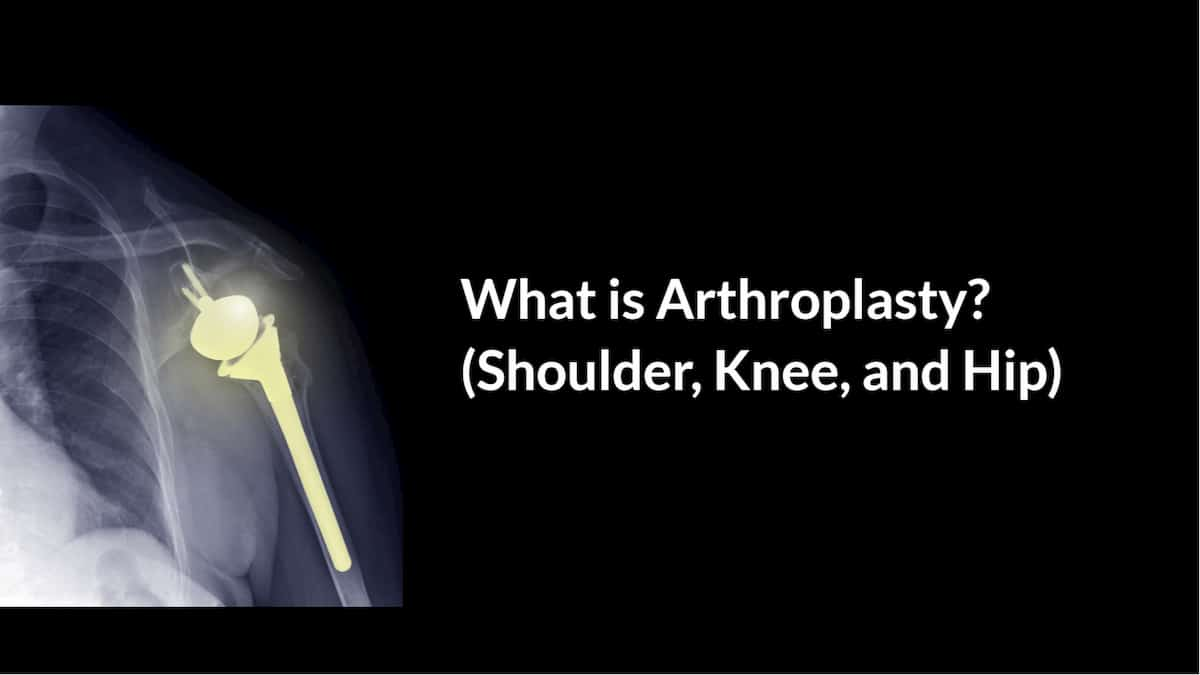What is Arthroplasty? (Shoulder. Knee, and Hip)
September 7th, 2020 | 5 min. read

Arthroplasty (joint replacement surgery) is a surgical procedure where a surgeon removes part of a damaged or arthritic joint and replaces it with a plastic, metal, or ceramic device, known as a prosthesis. The prosthesis is made to replicate a healthy, normal joint movement.
Knee and hip replacements are the most common types of arthroplasty performed, but surgeons can also perform arthroplasty on other joints too, including the:
- Elbow
- Wrist
- Ankle
- Shoulder
What Is Arthroplasty?
Before you learn the arthroplasty definition, first you'll learn more about the anatomy of your joints.
Your joint is where a couple or more bones meet. You have various types of joints within your body. For instance, your knee is a "hinge" joint since it has the ability to straighten and bend almost like a door with hinges. Your shoulder and hip joints are referred to as your "ball-and-socket" joint where the round end of a bone will fit into a cup-shaped location of another bone.
Arthroplasty restores joint function. A surgeon can restore a joint by resurfacing the bones. A prosthesis (artificial joint) might also be used.
Numerous types of arthritis might impact your joints. Degenerative joint disease, or osteoarthritis, is a loss of your cushion or cartilage in a joint and is a very common reason for arthroplasty.
What Are the Types of Arthroplasty?
As mentioned, knee, hip, and shoulder replacement are common types of arthroplasty. The surgery is used for treating damage from:
- Rheumatoid arthritis
- Osteoarthritis
- Osteonecrosis
- Joint injuries
- Other joint damage from injury or disease
The Difference Between Arthroplasty vs Joint Replacement
Joint replacement therapy and arthroplasty are really the same procedure. It's one of the most successful and advanced procedures performed in the healthcare industry.
But, the term "joint replacement" often scares people which is why many doctors use the term arthroplasty instead. Even so, joint replacement isn't as invasive as it sounds. Often, the surgeon just needs to remove a small part of your joint and replace it in a surgery known as partial joint replacement. But, this is only after they've tried various noninvasive methods first such as pain management and physical therapy.
These days, most arthroplasty surgeries are minimally invasive, which means the surgeon only has to make small incisions for removing and replacing damaged joint materials. Modern arthroplasty benefits are less damaging to tissue from surgery and quicker recovery times.
interested in a Shoulder, Hip, or knee arthroplasty procedure here in corpus christi, Texas?
Click the image below to request an appointment today with Coastal Orthopedics
Shoulder Arthroplasty: What Is It and Who Is It Best For?
Shoulder arthroplasty is a very successful surgery for reducing pain and restoring mobility in people who have end-stage shoulder arthritis and sometimes following a serious shoulder fracture. Shoulder arthroplasty helps relieve pain and restore shoulder:
- Strength
- Motion
- Function
A year after this procedure, 95% of individuals experience pain-free function which allows them to exercise their shoulder and restore motion and strength. Most individuals can go back to performing a physical activity like:
- Swimming
- Tennis
- Yoga
- Pilates
- Golf
Previously, they weren't able to perform these activities because of pain in their shoulder.
Some people aren't good candidates for this procedure. These include people who:
- Have active infections
- Experience symptoms that aren't substantially disabling
- Have a progressive nervous system disease that has impacted their joint (evaluated case-by-case)
- Experience paralysis or loss of deltoid and rotator cuff muscles
Total Knee Arthroplasty: What Is It and Who Is It Best For?
In knee arthroplasty, the surgeon removes portions of your bones that form your knee joint and replaces them with artificial implants. It's performed mainly for relieving stiffness and pain that osteoarthritis causes.
Most individuals who have this procedure have advanced knee arthritis where the cartilage in their knee is worn away and the knee surface becomes:
- Eroded
- Pitted
- Uneven
This leads to stiffness, pain, change in body alignment, and instability. Knee arthroplasty can also help certain individuals with a weakened knee joint due to a condition or injury.
You might want to think about knee arthroplasty if you have:
- Severe knee damage
- Knee deformity
- Knee pain
- A disability impacting your quality of life
Common reasons for knee arthroplasty are:
- Knee pain that persists even at rest
- Knee stiffness or pain limiting your daily activities
- Deformed knee joint
- Severe joint degeneration that shows on x-rays
- Other therapies like anti-inflammatory medicines, physical therapy, less invasive surgeries or joint injections haven't worked
If you decide on knee arthroplasty, talk with the surgeon to see if you're an ideal candidate for minimally invasive surgery. This could involve less pain and a faster recovery than open surgery. If just one part of the joint of your knee is damaged, see if partial knee replacement may be an option for you. With this procedure, the surgeon will remove one side of your joint.
Hip Arthroplasty: What Is It and Who Is It Best For?
Hip arthroplasty is where the surgeon removes and replaces portions of your femur (thighbone) and pelvis that form your hip joint. They perform this procedure mainly for relieving hip stiffness and pain hip arthritis causes.
This surgery is used, in some cases, for treating injuries like improperly growing or broken hip and for other medical conditions.
You might want to think about hip arthroplasty if you have hip joint damage that is causing pain and interfering with day-to-day activities despite receiving less invasive treatment.
Your physician might decide you're a good candidate for this procedure if:
- You have hip joint damaged caused by a health condition like rheumatoid arthritis, osteoarthritis, bone tumors or osteonecrosis
- You have hip joint damage caused by a fracture or injury
- Other surgical treatments failed to provide sufficient relief
- Nonsurgical management such as walking aids, exercise, and anti-inflammatory medicines hasn't worked
If you are a good candidate for this procedure it could involve less pain and quicker recovery than open surgery.
Orthopedic Evaluation
Your family doctor might refer you to an orthopedic surgeon for a comprehensive evaluation to see if you’d benefit from arthroplasty.
The orthopedic surgeon’s evaluation consists of a few components:
- A physical exam: This will evaluate joint stability, motion, and strength
- A medical history: The surgeon will gather your general health information and ask you about your ability to function and extent of your pain
- X-rays: These help in determining how extensive your joint damage is. They can also show normal joint space loss between bones, irregularity in the shape of your bone, irregularities, loose pieces of bone or cartilage, bone spurs or bone that might be floating inside your joint
- Various other testing: You may require other tests like an MRI, blood tests, or a bone scan to help the doctor determine the bone and soft tissue condition of your affected joint.
The surgeon will go over the results of your assessment with you and talk to you about if joint arthroplasty is the best treatment method for improving your function and relieving your pain.
Preparing for Arthroplasty
Like with any procedure, you'll have some preoperative considerations to think about which include, but aren't limited to:
- Exercise: Your body tends to heal and regain function quicker when you're in good cardiovascular and physical health.
- Autologous blood donation: Donating your blood before the procedure can ensure a matched blood source if required during or after the procedure.
- Medicine: Before your procedure, talk with your doctor about medicines you're currently taking. You might need to stop taking certain ones until after your procedure. Your surgeon will be the only one who can make this determination.
- Discharge planning: Like with any surgery, your doctor will provide you with a discharge plan before your procedure. This could include instructions on incision care, activities, pain medicines, special exercises as well as other instructions.
Recovery After Arthroplasty
Individuals who have had arthroplasty can still go on to live active, functional lifestyles. One huge part of any rehabilitation program is exercise for restoring mobility, function, and strength to the impact joint and your surrounding muscles. Talk with your doctor about what a proper, post-operative rehabilitation plan might include.
Consult with us here at Coastal Orthopedics for more specific pre and post-operative planning for your condition and type of arthroplasty.
Dr. Williams has been practicing orthopedic surgery in Corpus Christi since 1998. After graduating from Texas Tech hereceived his medical degree from the University of Texas at San Antonio. At the prestigious Campbell Clinic located at the University of Tennessee, Dr. Williams completed not only an Orthopedic Surgery Residency, but an additional year of Fellowship Training in Spine Surgery. Dr. Williams is dedicated to creating an excellent patient experience in the office or in the surgery suite.

